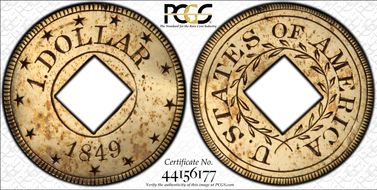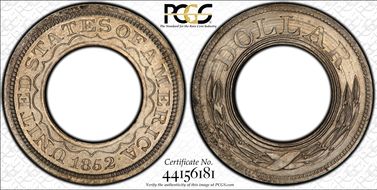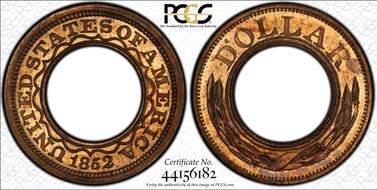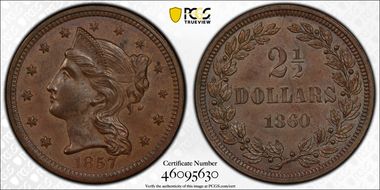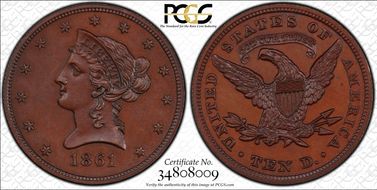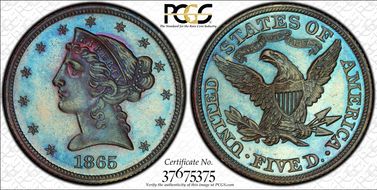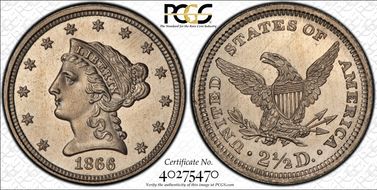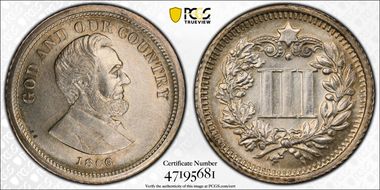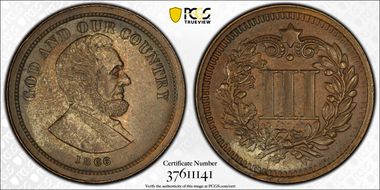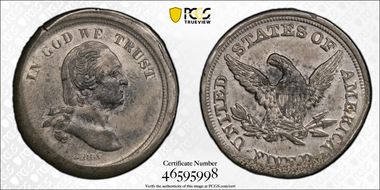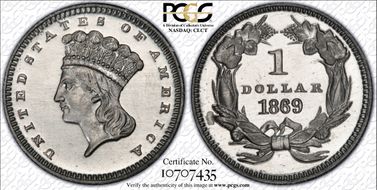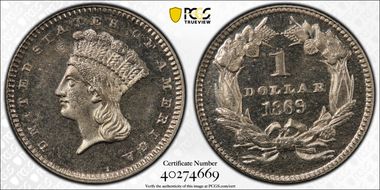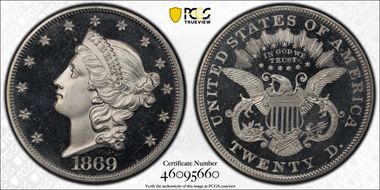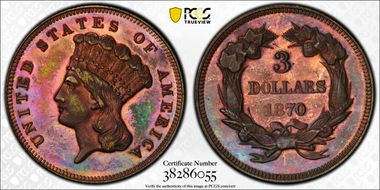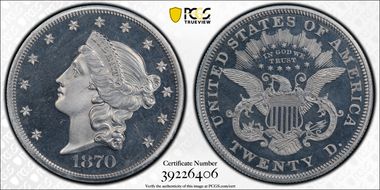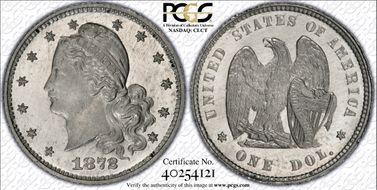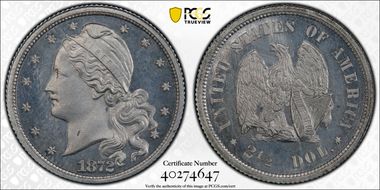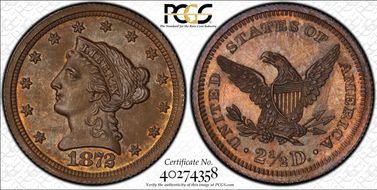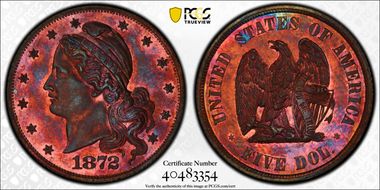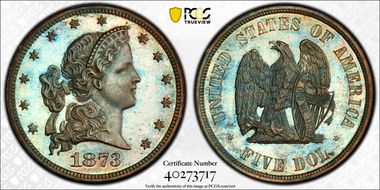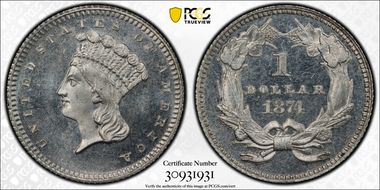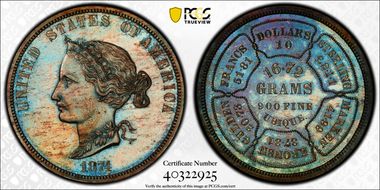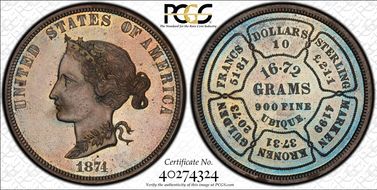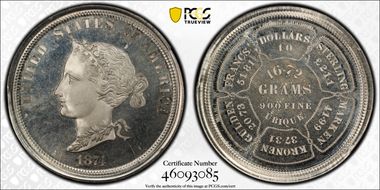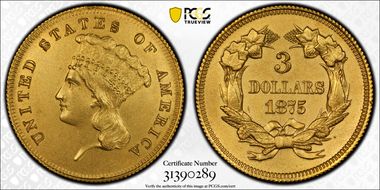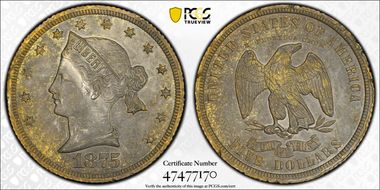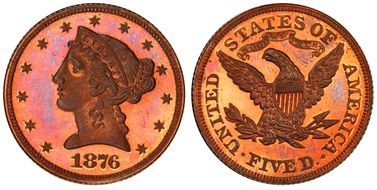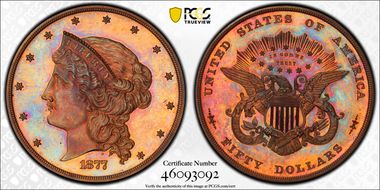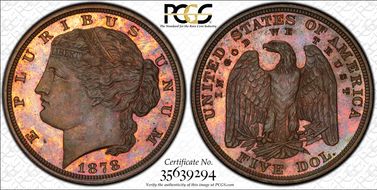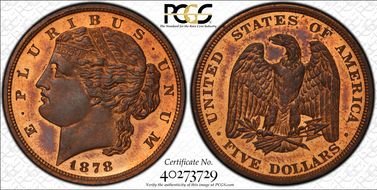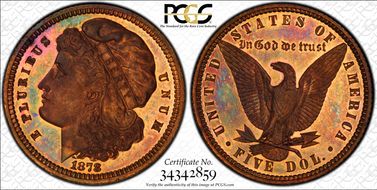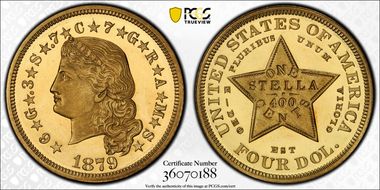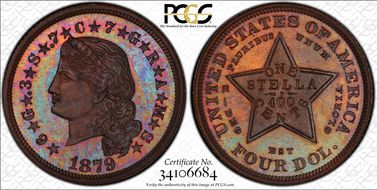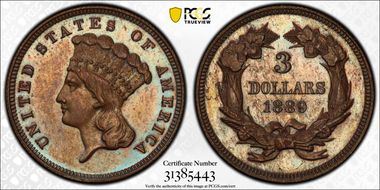Black Cat - Complete Gold Patterns - All Metals 的钱币相册
R8- Struck in silver with a plain edge. Struck from the obverse die of the regular issue 1804 BD-4 half eagle and from the reverse die of the regular issue 1804 BD-7 half eagle. A generally pewter-gray specimen with mottled toning in deep orange-russet and steely-charcoal. Well defined overall, especially in light of the extensively cracked and/or rusted state of the dies. Exceedingly Rare. EX: Mocatta Collection and possibly from Stack's sale of the Dr. Conway A. Bolt Collection, April 1966, lot 1607.
CAC - R7 in Copper. "This stunning Premium Gem displays vivid electric-blue toning over deeply mirrored fields with iridescent splashes primarily on the reverse. The surfaces are flawless." Ex. The Bob R. Simpson Collection.
CAC - High R.7 - Struck in gold-silver-copper alloy with a plain edge. The only CAC endorsed example. These extremely rare patterns were had cut by James Longacre and not die struck. This is the only U.S. pattern that was hand engraved. The necessity for hand-engraving and the larger history of these pieces is covered in an in-depth article in The Numismatist in October 2011, written by Ed Rector. In short, these patterns were emergency issues that were hand-engraved to simulate what a struck coin would look like with a square hole in it. They were needed in a hurry because a lame-duck Congressman from North Carolina, James Iver McKay, was pressing hard for the issuance of the pieces (mostly as an outlet for the gold mines from his native state). By January 26, 1849 Congressman McKay was in possession of one of these pieces. On January 30, six additional specimens were produced and sent by Mint Director Robert Maskell Patterson to other Congressmen. "The surfaces of this piece are bright with significant speckling on each side, presumably from the copper in the alloy." Ex. The Bob R. Simpson Collection.
CAC - High R.7 - Struck in gold-silver-copper alloy with a plain edge. The only CAC endorsed example. These extremely rare patterns were had cut by James Longacre and not die struck. This is the only U.S. pattern that was hand engraved. The necessity for hand-engraving and the larger history of these pieces is covered in an in-depth article in The Numismatist in October 2011, written by Ed Rector. In short, these patterns were emergency issues that were hand-engraved to simulate what a struck coin would look like with a square hole in it. They were needed in a hurry because a lame-duck Congressman from North Carolina, James Iver McKay, was pressing hard for the issuance of the pieces (mostly as an outlet for the gold mines from his native state). By January 26, 1849 Congressman McKay was in possession of one of these pieces. On January 30, six additional specimens were produced and sent by Mint Director Robert Maskell Patterson to other Congressmen. "The surfaces of this piece are bright with significant speckling on each side, presumably from the copper in the alloy." Ex. The Bob R. Simpson Collection.
CAC - High R.7 - Struck in gold-silver-copper alloy with a plain edge. The only CAC endorsed example. These extremely rare patterns were had cut by James Longacre and not die struck. This is the only U.S. pattern that was hand engraved. The necessity for hand-engraving and the larger history of these pieces is covered in an in-depth article in The Numismatist in October 2011, written by Ed Rector. In short, these patterns were emergency issues that were hand-engraved to simulate what a struck coin would look like with a square hole in it. They were needed in a hurry because a lame-duck Congressman from North Carolina, James Iver McKay, was pressing hard for the issuance of the pieces (mostly as an outlet for the gold mines from his native state). By January 26, 1849 Congressman McKay was in possession of one of these pieces. On January 30, six additional specimens were produced and sent by Mint Director Robert Maskell Patterson to other Congressmen. "The surfaces of this piece are bright with significant speckling on each side, presumably from the copper in the alloy." Ex. The Bob R. Simpson Collection.
CAC - R7 - Struck in silver with a plain edge. Obv: Annular, or ring-form design with USA above and the date 1852 below the central perforation. Rev: "A wreath of laurel leaves encircles the central perforation. Silver gray on the obverse, the reverse is lightly toned with more of a golden-gray appearance. Both sides are sharply defined for all design elements and deliver satiny mint luster."
CAC - Low R7 - Struck in gold with a plain edge. Tied for the finest at PCGS and the finest endorsed at CAC (5/24). The obverse has the letters USA above and the date below. The reverse design has the denomination expressed as DOLLAR above and a wreath below. "The surfaces are bright and also show evidence of the 10% copper in the alloy with the obverse displaying considerable reddish patina." Ex. Simpson
CAC - R7 - Struck on an annular silver planchet with a plain edge. Both thick and thin planchets with fewer than a dozen confirmed, of which 5 are in museums. Only 5 are graded (6/22) at both PCGS (2) and NGC (3) and some of those may be duplicate submissions. "Light, even gray-golden patina is seen over each side." Ex. The Bob R. Simpson Collection.
CAC - R7 - Struck in copper with a plain edge. Tied with the finest graded at either service (5/22) and the finest endorsed at CAC 5/22. Obv: The legend UNITED STATES OF AMERICA above and the date 1852 below the central perforation. A crenulated line design encircles the perforation. Rev: The denomination DOLLAR above and an ornamental wreath below the central perforation. "A blazing, fiery deep red and rose Gem with intense luster and amazing aesthetic appeal. Additionally, the strike is bold to sharp and readily equal to the challenge of the grade." Ex. Thomas H. Sebring Collection
CAC - R7 - Struck in copper with a plain edge. Tied with the finest graded at either service (5/22) and the finest endorsed at CAC 5/22. Obv: The legend UNITED STATES OF AMERICA above and the date 1852 below the central perforation. A crenulated line design encircles the perforation. Rev: The denomination DOLLAR above and an ornamental wreath below the central perforation. "A blazing, fiery deep red and rose Gem with intense luster and amazing aesthetic appeal. Additionally, the strike is bold to sharp and readily equal to the challenge of the grade." Ex. Thomas H. Sebring Collection
CAC - Low R.7 - Struck on an annular copper-nickel planchet with a plain edge. 1852 Annual Gold Dollar in Copper. The obverse features a line design, described as a circle of six bows by early catalogers, around the central perforation. The legend UNITED STATES OF AMERICA around, with 1852 below. The reverse consists of the denomination DOLLAR above, and an open wreath below. Struck on an annular copper-nickel planchet with a plain edge. "Flashy coppery-orange surfaces exhibit splashes of blue and violet color, as well as deeper elements of tan-gold." Ex. Bob R. Simpson Collection.
CAC - R.7 - Struck in copper with a reeded edge. The obverse depicts Liberty facing left, her hair flowing down to the shoulder, wearing a coronet inscribed LIBERTY, with 13 stars around and the date below. This Longacre obverse is dated 1857 and was used on Judd-189, reappearing on regular issue three cent nickel pieces in 1865. The 1860-dated reverse has the denomination, 2 ½ DOLLARS, and the date within a laurel wreath. The statutory legend is conspicuously absent. "Glossy golden-brown and mahogany surfaces show glimpses of powder-blue and violet on the reverse, while hints of faded mint red color appear on the obverse." Ex: J. Hewitt Judd Collection (plated in the first seven editions of the Judd reference); Abe Kosoff (1971), The Harry W. Bass, Jr. Core Collection, Part I.
CAC - Low R.6 - Struck in copper with a reeded edge, then bronzed at the Mint. The finest CAC endorsed coin. The designs are the same as the issued 1863 ten dollar piece, except that GOD OUR TRUST is placed on a scroll in the upper reverse field. "The design elements are sharply detailed throughout and the impeccably preserved medium brown surfaces show attractive highlights of olive in selected areas." Ex Simpson.
CAC - High R.7. Struck in nickel with a reeded edge. Tied for Finest. "The fields are nicely mirrored and a uniform rose-gray color, contrasting well against frosted devices. A subtle effect of planchet striations running diagonally southwest to northeast is neither overt nor distracting. This piece is tied for finest certified with a PR67 Cameo piece at NGC, which may be the same coin (9/20)." Ex: The Bob R. Simpson Collection, Part II
High R7+ - Struck in Gold with a Reeded Edge. Obv: A bearded bust of President Lincoln faces right, the motto GOD AND OUR COUNTRY above and the date 1866 below. Rev: A wreath of oak and laurel surrounds the denomination expressed as a Roman numeral III. Scroll ornamentation is at the top of the wreath, above which is a six-pointed star. Delightful satin to softly frosted surfaces display a sharp to full strike throughout. Even medium gold color on both sides.
CAC - R8 with 3 known including one in the Smithsonian. Struck in silver with reeded edge. The only one graded at PCGS (8/23). Bust of Abraham Lincoln right with the motto GOD AND OUR COUNTRY above, date 1866 below. Rev: The denomination as a Roman numeral III is centered within an oak and laurel wreath. The wreath has some scroll ornamentation at its apex and is surmounted by a six-pointed star. Lovely satin surfaces are smooth, lustrous and framed by halos of delicate champagne-apricot iridescence. RARE
Unique -Private pattern - Struck in brass with a reeded edge, medallic turn. Struck by Merriam. As per USPatterns.com, this piece was unknown to Judd & Pollock and was examined by PCGS in May 2019. It is 91% Cu, 9% Zn, and weighs 4.24 grams. "The brown surfaces display deeper gray patina on each side. An unusual and rare private-issue pattern."
CAC - Unique -Struck out of collar in white metal with a plain edge. "The obverse uses a Washington five cent pattern die, while the reverse employs the normal No Motto half eagle reverse of the pre-1866 era.The coin displays uniform nickel-gray patina with gunmetal overtones. Detail is pleasing, and minimal marks are noted." EX. Historical Scholar Collection
CAC - Low R7 - Struck in copper with a reeded edge. Low Date Variant. The only one endorsed by CAC. The obverse features a left facing bust of Liberty by James Barton Longacre. Thirteen stars are arranged around the border, and the date is below. An eagle with outstretched wings dominates the reverse design. The motto IN GOD WE TRUST is on a scroll in the upper field, the legend and the denomination are near the periphery. "This specimen mixes die striations with wispy hairlines and is a light reddish-brown color with occasional mint-green accents."
CAC - Unique. Struck in nickel with a reeded edge. " ... is brilliant nickel-gray with moderately frosted devices." Ex: The Bob R. Simpson Collection, Part III
CAC - High R.7 - Regular die trials issue struck in aluminum with a reeded edge. Four or Five known - The finest Graded. This is the only Deep Cameo example certified as of 03/24. "The fields are deeply mirrored and establish an almost total black background for the frosted, white devices." Ex: DiBello Collection (Stack's, 5/1970), The Harry W. Bass, Jr. Core Collection, Part II.
CAC - R7 - This rare die trial piece is struck from regular issue dies in aluminum with a reeded edge. James Longacre's standard design for the regular issue double eagles of 1870. As per USPatterns.com, only three are believed to be known and one of the 3 is slightly impaired. Deep mirrors beam boldly from all over and exhibit strong clarity and are clean. Miss Liberty and the details are fully struck and have thick standout frost. The only deep cameo graded by either service. Ex: Simpson Collection.
CAC - R.8 - OGH - The only known example - The regular proof dies for the 1871 quarter eagle, struck in aluminum with a reeded edge. "...both sides exhibit strong cameo contrast. Fully mirrored light gray fields provide an exquisite background for the lustrous and sharply detailed devices." Ex. Estate of Charles W. Montgomery.
CAC - R.8 - OGH - The only known example - The regular proof dies for the 1871 quarter eagle, struck in aluminum with a reeded edge. "...both sides exhibit strong cameo contrast. Fully mirrored light gray fields provide an exquisite background for the lustrous and sharply detailed devices." Ex. Estate of Charles W. Montgomery.
CAC - R.8 - Struck in aluminum with a reeded edge. Only three pieces are known in aluminum. "The fields are deeply mirrored and show pronounced die striations. The devices are nicely frosted and give the piece a stark cameo contrast." Ex: Farouk-Sieck - Simpson
CAC - R.8 - Struck in aluminum with a reeded edge. Only three pieces are known in aluminum. "This exceptional piece is arguably the finest by virtue of its Plus designation. The surfaces are brilliant throughout and the aluminum alloy shows the expected depth of reflectivity in the fields along with frosted devices. Ex: Pittman-Simpson.
CAC - R.8 - The regular-issue quarter eagle dies. Struck in copper with a reeded edge. Only two examples of Judd-1233 are confirmed. Tied for the finest certified and the only CAC endorsed example. "This deep brown representative retains flashes of original mint red color in the hidden areas." Ex. Bob R. Simpson Collection, Part V.
CAC - High R.7 - Five Examples Extant -Two of them are gilt. Struck in copper with a reeded edge. "Olive-gold and ocean-blue tones cover glossy brown surfaces. Essentially void of carbon or contact." Ex: The Bob R. Simpson Collection, Part II
CAC - R8. The Finer of Only Two Pieces Known. Struck in aluminum with a reeded edge. "As expected from an aluminum striking, the fields are deeply mirrored and the devices frosted white, which provides the cameo contrast on each side. Fully struck in all areas with no obvious contact marks or signs of oxidation." Ex: The Bob R. Simpson Collection, Part V
CAC - R8 - Struck in aluminum with a reeded edge. Only two coins known. A regular dies trial piece. "This sharply defined Premium Gem Cameo proof has excellent contrast with light gray devices within a blue-gray frame." Ex. Simpson
CAC - Low R7. Struck in copper with a plain edge. "This Gem example has glossy original brown surfaces, with undertones of vivid blue and violet in the fields when tilted beneath a light. " Ex. The Bob R. Simpson Collection
CAC - R8 - Struck in aluminum with a reeded edge. $10 Bickford. This is one of only two examples of Judd-1376 known. The obverse depicts a bust of Liberty facing left with the legend UNITED STATES OF AMERICA above and the date below. Liberty wears a diadem inscribed with the word LIBERTY and ornamented with six stars. The weight 16.72 GRAMS, the standard of the metal 900 FINE, and the word UBIQUE are centered on the reverse. Around the periphery is the U.S. denomination DOLLARS 10 and the following international equivalents: STERLING (Pound) 2.1.1; MARKEN 41.99; KRONEN 37.31; GULDEN 20.73; and FRANCS 51.81. "The surfaces of this Gem Cameo proof exhibit pronounced black-and-white contrast, with deeply reflective fields and thickly frosted devices typical of an aluminum pattern. Delicate streaks of thin golden patina appear over each side without minimizing the overwhelming brilliance." Ex: Simpson.
CAC - R8 - Struck in aluminum with a reeded edge. $10 Bickford. This is one of only two examples of Judd-1376 known. The obverse depicts a bust of Liberty facing left with the legend UNITED STATES OF AMERICA above and the date below. Liberty wears a diadem inscribed with the word LIBERTY and ornamented with six stars. The weight 16.72 GRAMS, the standard of the metal 900 FINE, and the word UBIQUE are centered on the reverse. Around the periphery is the U.S. denomination DOLLARS 10 and the following international equivalents: STERLING (Pound) 2.1.1; MARKEN 41.99; KRONEN 37.31; GULDEN 20.73; and FRANCS 51.81. "The surfaces of this Gem Cameo proof exhibit pronounced black-and-white contrast, with deeply reflective fields and thickly frosted devices typical of an aluminum pattern. Delicate streaks of thin golden patina appear over each side without minimizing the overwhelming brilliance." Ex: Simpson.
CAC - High R.7- Only Two or Three Known. $10 Bickford - Struck in nickel with a reeded edge. "The obverse depicts a bust of Liberty facing left with the legend UNITED STATES OF AMERICA above and the date below. Liberty wears a diadem inscribed with the word LIBERTY and ornamented with six stars. The weight 16.72 GRAMS, the standard of the metal 900 FINE, and the word UBIQUE are centered on the reverse. Around the periphery is the U.S. denomination DOLLARS 10 and the following international equivalents: STERLING (Pound) 2.1.1; MARKEN 41.99; KRONEN 37.31; GULDEN 20.73; and FRANCS 51.81." Ex: Simpson.
CAC - R.8 - One of Two Known. Struck in nickel with a plain edge. Broadstruck. "The fields are bright silver-gray with near-white mint frost over the design elements, the combination providing a distinct cameo effect." Ex: William Woodin, exhibited at the 1914 ANS exhibit; "Colonel" Green; Kreisberg-Schulman (2/1960); gifted by Brinton T. Shorer (5/3/1973) via Mike Brownlee. From The Harry W. Bass, Jr. Core Collection, Part II.
CAC - R8 - Guilt. Regular dies trial striking for the three dollar gold piece. T"he lustrous, satiny light yellow surfaces are pristine, lacking marks on either side." This is the only example that PCGS has certified (12/23)
Unique - Struck in white with a reeded edge. "William Barber's famous Sailor Head design, the obverse features a head of Liberty facing left. The drapery over Liberty's shoulders presents the appearance of a collar on a sailor's uniform. Also, the word Liberty is set on a squared-off coronet with two trailing ribbons, this also resembling a sailor's cap. On the reverse, an eagle similar to the one featured on the regular issue twenty cent piece is poised in heraldic fashion. Beneath the eagle is a ribbon with the motto IN GOD WE TRUST, and above the words E PLURIBUS UNUM are set directly onto the field in tiny letters." Ex: Dr. Henry R. Linderman, King Farouk, Abe Kosoff; Kosoff Collection
CAC - "This flashy piece is fully struck and shows beautiful orange-yellow toning. The preservation is exemplary, and the gilding is well-executed, with no indication of the underlying copper, even over the high points."
CAC - Low R.7 - Stuck in copper with a reeded edge. 1877 Half Union in Copper - The finest endorsed by CAC. The obverse features a large Liberty Head design by William Barber, while the reverse design is similar to contemporary double eagles, except for FIFTY DOLLARS, which appears along the bottom rim. "Incredible splashes of rich violet, rose, and blue fairly leap from the surfaces of this beautiful pattern." That iridescence remains throughout this coppery-gold proof." Ex: Harry W. Bass, Jr. Collection.
CAC - Low R.7. Struck in copper with a reeded edge. Certified Red and Brown, there is a strong presence of original mint red in the fields on each side with the Brown almost exclusively limited to the devices." Ex: The Bob R. Simpson Collection, Part II
CAC - R6+ - Struck in Copper. The Barber design with flowing hair. Tied for FINEST graded in the RB category (5/22). "Ultra flashy copper fields have a bold reflection and deep mirrors. The original RED is fiery and intense with just a dusting of violet-azure that is gracefully dusted on the surfaces. The devices show precision details, fully struck up and with full definition from an exacting blow. Nearly FLAWLESS". Ex. Glorious
CAC - R6+ - Struck in Copper. The Barber design with flowing hair. Tied for FINEST graded in the RB category (5/22). "Ultra flashy copper fields have a bold reflection and deep mirrors. The original RED is fiery and intense with just a dusting of violet-azure that is gracefully dusted on the surfaces. The devices show precision details, fully struck up and with full definition from an exacting blow. Nearly FLAWLESS". Ex. Glorious
CAC - High R-7- Struck in aluminum with a reeded edge with only five known in aluminum. This Superb specimen has bright surfaces with mirrored fields. Tied with the finest graded and the only coin endorsed by CAC. The aluminum striking's are estimated to be fifty times rarer than their gold counterparts. Ex. Harry W. Bass, Jr. Research Foundation
CAC - High R-7- Struck in aluminum with a reeded edge with only five known in aluminum. This Superb specimen has bright surfaces with mirrored fields. Tied with the finest graded and the only coin endorsed by CAC. The aluminum striking's are estimated to be fifty times rarer than their gold counterparts. Ex. Harry W. Bass, Jr. Research Foundation
Unique - White Metal with Reeded Edge. "The fields are irregular, having a texture somewhat reminiscent of the "orange peel" type surface found on Proof gold coins of the period.... Perhaps the most significant physical attribute of this piece is that it is overstruck on what appears to be a cut down white metal pattern of a different denomination/type. Remnants of the under type are discernible on both sides but not with enough detail to enable positive attribution." Ex N.M, Kaufman
Unique - White Metal with Reeded Edge. "The fields are irregular, having a texture somewhat reminiscent of the "orange peel" type surface found on Proof gold coins of the period.... Perhaps the most significant physical attribute of this piece is that it is overstruck on what appears to be a cut down white metal pattern of a different denomination/type. Remnants of the under type are discernible on both sides but not with enough detail to enable positive attribution." Ex N.M, Kaufman
CAC - Unique - Struck in copper with a reeded edge. The sole pattern issue produced in 1889. The regular issue obverse and reverse design for the three dollar gold piece. "...rich chocolate-brown and olive color, graced by pale blue toning. Both sides have reflective and partially mirrored fields.". Ex. Simpson
























